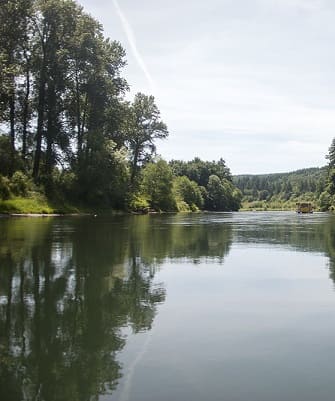
Cowlitz Indian Tribe Facts
The men and women who form the small Northwest Coast American Indian tribe in the western part of Washington State are called the Cowlitz Indians. They are a group of people rich in history and culture. For example, when Cowlitz kids reached adolescence, they embarked on a fasting journey where they would search for a spiritual guide to assist them in their roles as productive tribe members. On this page, you will find more interesting facts and information on the tribe, including what foods they ate, and how they made their homes, weapons, clothing, and jewelry.
Click here for a great selection of Cowlitz Indian books on AMAZONCowlitz Indian Basketry Facts
- Cowlitz were known for their beautiful, finely woven basketry, which was often passed down from one generation to the next.
- The baskets were almost always made in the shape of an inverted cone and served many purposes. These beautiful pieces of art were used for cooking, collecting fruits and other types of food, and for storage.
- The Cowlitz women used materials such as cedar root and cedar bark to make the baskets, along with dye from such things as the bark of wild cherries and alder. Each woman used the bark from their own designated basket tree, which was a red cedar tree.
Cowlitz Indian General Facts
- The Cowlitz Indians get their name from the Cowlitz River.
- The Cowlitz Indian Tribe owns and operates the ilani Casino located near La Center, Washington.
- The Cowlitz Indians lived in wooden plank houses, similar to longhouses, but the roofs were always made from cedar planks.
- The Cowlitz lived in two separate groups, the Upper Cowlitz and the Lower Cowlitz (who were more numerous).The Upper Cowlitz lived approximately 17 miles (27.4 kilometers) below the peak of one of the most dangerous volcanoes in the United States, Mount Rainier.
- Both groups of these Native Americans had access to natural resources that they used as medicines such as the Easter Lilly, which was used for eye wash.
- Around 1816, a Canadian named Simon Plamondon encountered the Cowlitz on a leisurely adventure as a young man. He was captured by the chief of the lower Cowlitz, Chief Scanewa. He was released with the agreement that he would bring back items to trade. He eventually proved himself as trustworthy, and upon the chief's death, he inherited much of his land.
- The Cowlitz were spiritual people who performed sun dance celebrations where they danced and sang in fields for a period lasting three days.
- Like most other Indian tribes, the Cowlitz liked to barter for goods. Popular items included horses, hides, baskets, plants, meats, and even slaves.
Cowlitz Hardship Facts
- In the late 1920s, many of the Cowlitz people were faced with an epidemic, believed to be the Asian flu, which wiped out a large portion of tribe members. Today there are approximately 1,500 living members.
- With Salmon a large part of the Cowlitz way of life, it was particularly distressing to them when the state began enforcing wildlife regulations, initially prohibiting them from fishing. Eventually, ID cards were distributed that allowed them to once again continue with their way of life.
- The Cowlitz leaders fought hard in the early 1900s to establish a designated territory where the tribe could live peacefully off the land. They were unsuccessful in negotiating with the U.S. government, and not only were two potential treaties never signed, but much of their land was taken away.